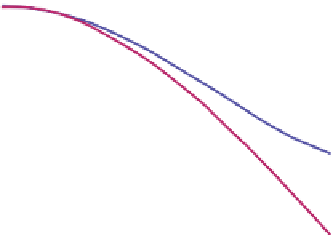Geology Reference
In-Depth Information
0.3
0.4
0.3
0.2
0.2
0.1
0.1
0
0
-0.1
-0.1
-0.2
-0.2
-0.3
-0.3
-0.4
1.4
1.6
1.8
2.0
2.2
2.4
-0.4
V
p
/V
s
-0.1
0
0.1
0.2
0.3
0.4
lms
sh
ss
model
ε
Pierre shale
East Texas sand & chalk
East Texas shale
East Texas marl
S. China sea shale
North sea shale
North sea chalk
Java sea shale
W. Africa unattrib
Figure 5.44
Relationship of
δ
with
V
p
/
V
s
for rock with weak polar
anisotropy. Data from Ryan-Grigor (
1997
).
0.1
isotropic
TI
Figure 5.43
Vertical polar anisotropy data derived from multi-
offset VSPs (after Macbeth,
2002
) ©Elsevier and reproduced with
permission.
0.05
0
-0.05
close to zero in sands might suggest
that
the
-0.1
'
effect of vertical polar anisotropy is to
enhance negative gradients and stretch the gradient
relative to the intercept.
Figure 5.45
shows an
example comparing a Class IIp top oil sand
response with and without including polar anisot-
ropy in the overlying shale. The anisotropy
becomes important in terms of the amplitude and
the AVO gradient beyond an angle of incidence of
around 30°. In
Fig. 5.45
the amplitude of the aniso-
tropic case at 40° is 50% higher in absolute terms
than the isotropic model.
It is possible therefore that this type of anisot-
ropy could generate false positive hydrocarbon
indicators, for example in the case of Class II wet
sands, although, as previously stated, there are no
definitive published examples. Equally, it is possible
that layered sections of shales may have variations
of
normal
'
-0.15
-0.2
-0.25
0
10
20
30
40
50
Angle of incidence
V
p
2.438
2.953
V
s
1.006
1.774
ρ
2.250
2.036
δ
0.150
0.000
ε
0.020
0.000
layer 1
layer 2
Figure 5.45
the effect on the top
reservoir response is to steepen the gradient if the difference in
Shale on oil sand model
-
δ
(i.e.
δ
2
δ
1
) is negative.
values, for example owing to changes in
organic content or pressure, that could lead to
AVO anomalies dominated by the anisotropic com-
ponent. This is perhaps one explanation of some
AVO failures in which no reservoir was found (e.g.
Allen and Peddy,
1993
).
δ
5.3.7.2 Azimuthal anisotropy
Most rock formations have sub-vertical fracture
systems caused by stresses within the crust. Fractures
that relate to the extensional parts of the current stress
87

























































































































